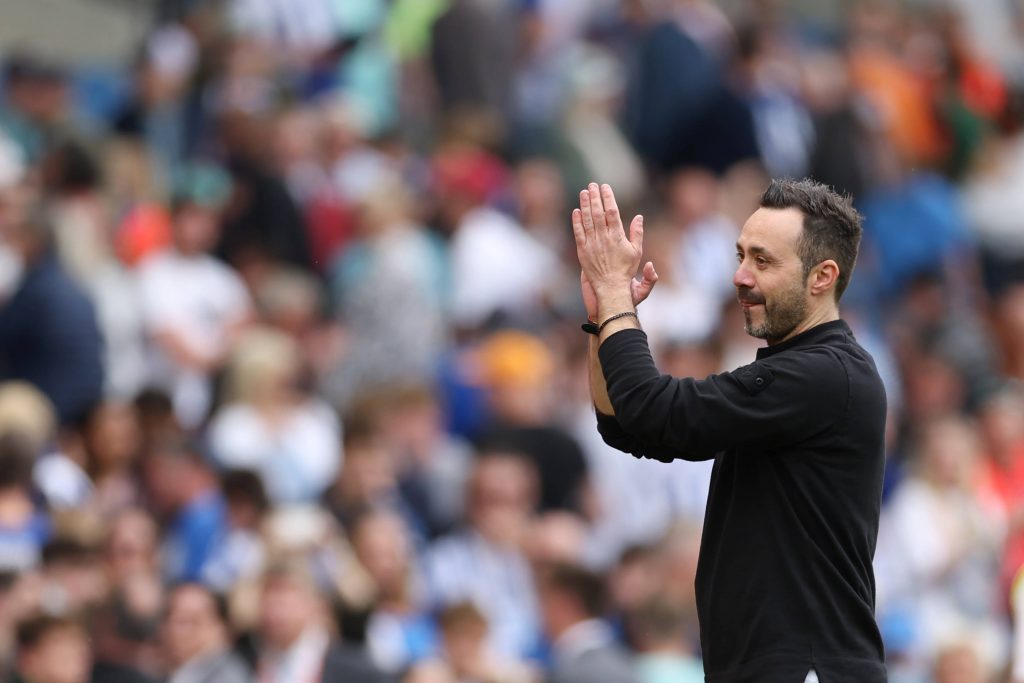Jamie Scott looks at an interesting facet of how Roberto De Zerbi has Brighton playing
Roberto De Zerbi’s Brighton and Hove Albion have taken the Premier League by storm, with their unique tactical game. Many analysts think Brighton’s principles of play are heavily predicated towards a spatial approach, by drawing teams out by baiting the press, creating artificial transitions/counter-attacks, or by utilising minimum and maximum width simultaneously. And none of these analyses are wrong. But Brighton’s play can be analysed through a different lens – rather than studying their play with a bias for spatial facets, I will highlight the importance of temporal factors to their play. In other words, why different timings in combinations and the rates of play happening in each phase are absolutely crucial to their approach.
De Zerbi’s Brighton: A Holistic Summary
Brighton typically line up in a nominal 4-2-3-1 formation, as outlined below.
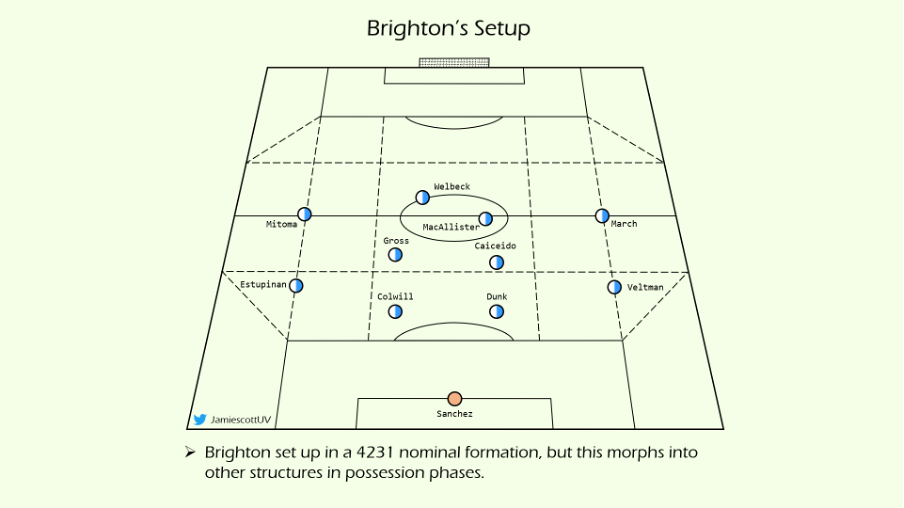
Brighton, obviously, form very different structures in each phase of in-possession play, akin to how many modern teams play. Brighton collapse their build-up structure in order to create a compact 4-2 or 4-1 structure to build out through. The compact nature of the build-up structure often draw opposition teams in, high and narrow in their press, towards Brighton’s core of players.
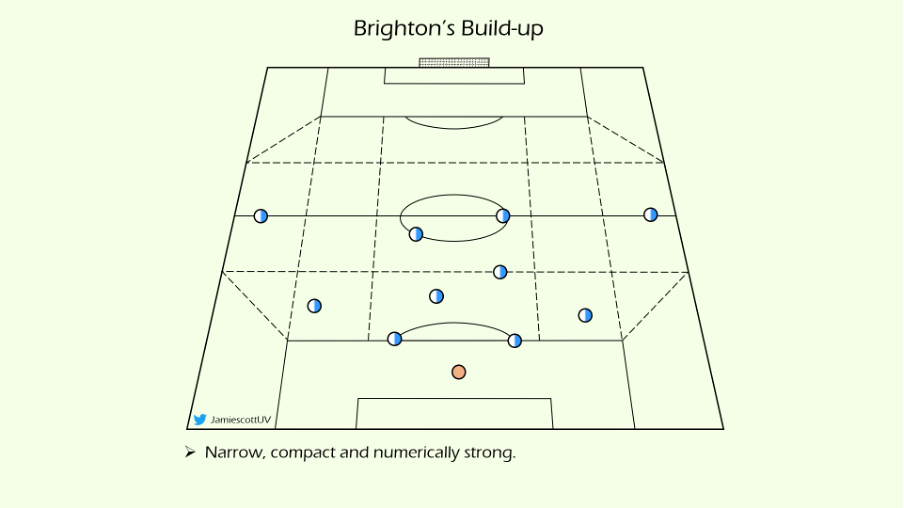
In attacking phases, Brighton then use maximum width to capitalise on the exposed position their opposition often find themselves in, having had their press played through. This allows Brighton’s wingers to attack in 1v1 scenarios, should they receive to feet, as the opposition backline is stretched laterally.

Much of this play is predicated upon creating numerical superiorities, to then arrive in scenarios where the team have spatial, or qualitative superiorities. To elaborate, Brighton create a numerical overload in the build-up, by shunting the keeper forwards as a +1 in the backline, narrowing the fullbacks, and dropping one (or both) of the double pivot, to create a sum or six or seven players, in a small amount of space. This then draws the opposition onto Brighton. Such is the quality of De Zerbi’s coaching, the individual quality of Colwill, Caiceido, MacAllister and others, and the numerical advantages Brighton create, that the opposition often struggle to prevent Brighton from playing through their press, or high-block (depending on which defensive structure the opposition deploys). Brighton can subsequently cash-in, consistently, in attacking phases as a result.
Temporal Features of Brighton’s Play
De Zerbi’s Brighton team can be viewed as masters of numbers, and space. It makes sense. It’s tangible, observable, plain to see. But the more abstract nature of speed of play is worth a strong consideration, as it is where I feel the true value add is. That’s the real USP of this team, and their successes.
Build-up: Painfully Slow – Until a Point
It isn’t uncommon for Brighton players to linger on the ball at the back (or in other areas of build-up for that matter). An example which highlights the effect of this apparently lethargy, is explained below. Buonanotte, takes an extended period on the ball. He is carrying the ball laterally, seemingly probing for an opening to progress through. But the effect of his action, regardless of intention, is Joelinton being drawn in. When Joelinton jumps into the challenge, Buonanotte lays the ball off to the security ring (players in the first line of build-up).
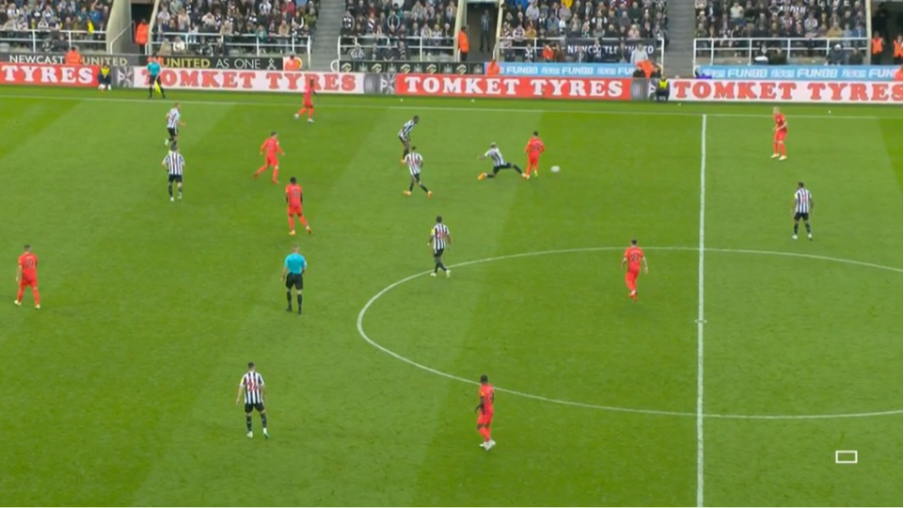
Because Joelinton forces a backwards pass, Newcastle are triggered into a press. The team squeeze up, compact across to the ball side, and certain pressing players jump up by one line to press. Brighton, however, are able to play through the press, using player combinations as discussed in the section above. The result of Buonanotte slowing play down is that Brighton can draw Newcastle across. Brighton subsequently have space to play into, down their left, and Newcastle are left in a state of ‘recovery’.
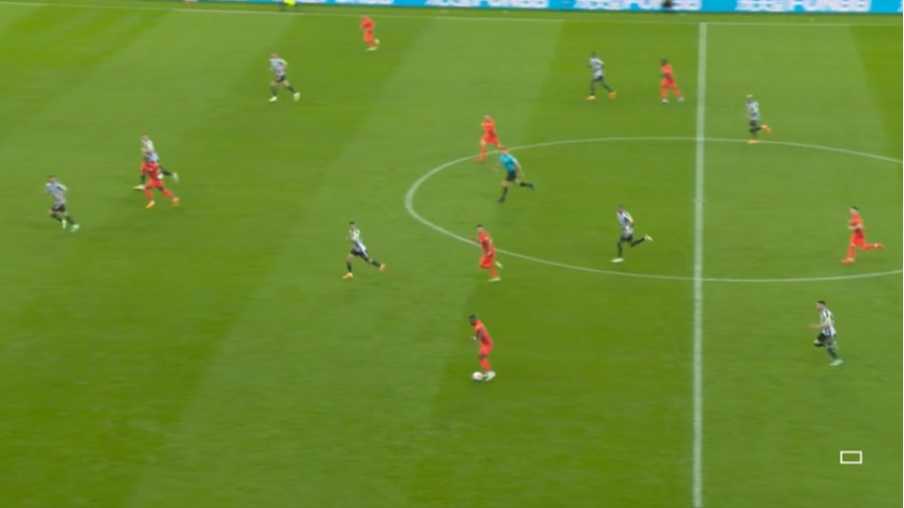
Teams that are defending in a ‘recovery’ scenario (for example, defending a counter-attack, or defensive transition after losing the ball), must prioritise settling back into their regular defensive shape, and must delay rather than engage in 1v1s. Newcastle were sucked into a press by Brighton’s apparent lethargy in the initial instance, yet found themselves in a defensive transition-like scenario as a consequence. An additional point of real interest – is it worth considering how macro aspects of the game, such as the phase of play, affects individuals playing for Brighton? To elaborate, Mitoma often finds himself driving at defenders in an advantageous 1v1. Mitoma’s ball-carrying numbers are excellent, but is this a result of defenders choosing to delay him, by backing off, rather than engaging (as a result of the gamestate)? Or is it because Mitoma is a world-class dribbler? The answer is probably a combination of the two, but the macro factor is rarely considered when it comes to Mitoma and Brighton – at least not through this lens.
Perhaps less interestingly, because it is so widely documented, we should also consider the ‘pausa’ that Brighton deploy in build-up. It’s not uncommon to see a centreback like Lewis Dunk simply place their foot on the ball and stop, merely waiting for the opposition to step up or engage. It is a very similar concept to the above, where slowing play down induces an effect on the opposition block; at minimum, drawing their block higher, but optimally, drawing them into a press. When the press is elicited, Brighton use their qualities to play through it and exploit the attacking scenario at hand – often a transition-like state.
It is also worth noting that the ‘rest-defences’ of the opposition are effectively rendered moot here, because the team isn’t in an in-possession phase – rather, they are pressing Brighton. Because of Brighton’s qualities however, the opposition often find themselves scrambling to recover – hence, the transition-like state. The lack of input from a rest defence is atypical for a team that is exposed to a defensive transition, because most modern teams set up with a strong defensive shape, even when on the ball, to mitigate risks on the counter when they lose it.
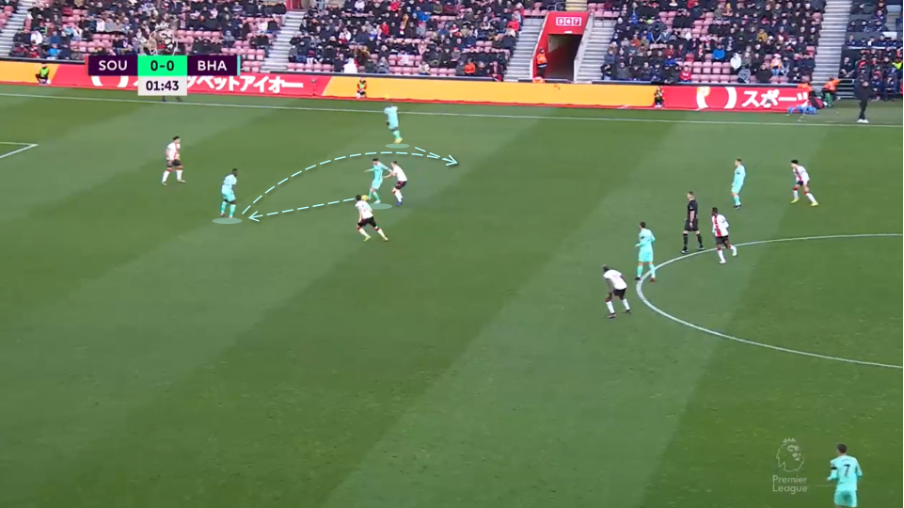
Progression & Attacking Phases: Speedy, Direct, Efficient and Effective
In stark contrast to Brighton’s build-up play, De Zerbi’s side zip through the progression phase at great pace, and attack ruthlessly once in the final third. There must be some consideration for the fact that Brighton’s progression phase is typically quite small from a spatial perspective: because they draw the opposition block up the pitch, there is little space to play through between build-up and attack.

But irrespective of whether the lack of space Brighton have to play through has an impact on how quick their progression phase seems, the intent is certainly to play through the lines at great speed. Once Brighton have drawn the press onto their build-up, they seek to find their front line as quickly as possible. The reasons for this are simple: if they’re risking drawing a press upon themselves, it is best to maximise the upside of inducing those scenarios. Brighton do this by capitalising on the opponent’s disorganisation, once they’ve played through their press, by progressing and attacking at speed.
At times, the goalkeeper helps Brighton bypass progression altogether. Jason Steele has often replaced Robert Sanchez in goal, by virtue of his ability on the ball. Against Arsenal for example, Steele performed multiple chipped balls directly over the press, into the attacking line. Brighton still had a prolonger build-up phase; by no means were they just going long. Crucially though, they accessed the attacking phase at great speed.
This may seem to be a tangent, but one of the greatest advantages of minimum width is that the team is closer to the centre of the pitch, and therefore, the goal they are attacking. This means the ball has to travel less distance to the goal, when the team attacks, thus, speeding up the attack. Teams adhering to minimum width, such as those classic ‘Red Bull’ sides, Jesse March’s Leeds, or Nagelsmann’s Bayern, often play in quite a frenetic, intense, high-pressing style of play, which often sees them attack in transitions, after possession turns over. They use minimum width to minimise the time it takes to attack, therefore reaping rewards by exposing the disorganised shape of the opposition post-turnover. De Zerbi’s Brighton adhere to a similar philosophy in terms of attack speed, as they often play in attacking transition-like states, but De Zerbi’s side use maximal width. They facilitate a high speed of attack despite the width of the front line, which is interesting to understand from a conceptual standpoint, and quite unique.
There are two main ways that Brighton maintain a high speed of attack. Firstly, as discussed before, slowing play down to induce a press, allows Brighton to attack versus a ‘delay first’ defensive mindset. This allows dribblers such as Mitoma and March, who often receive on the by-line (as wide as possible), to drive play forwards into the opponent’s defensive third. Furthermore, Brighton often look to create dynamic superiorities, not spatial superiorities. They like to access players who are either running into space, or are already in movement and therefore can maintain the attack’s momentum when they receive to feet.
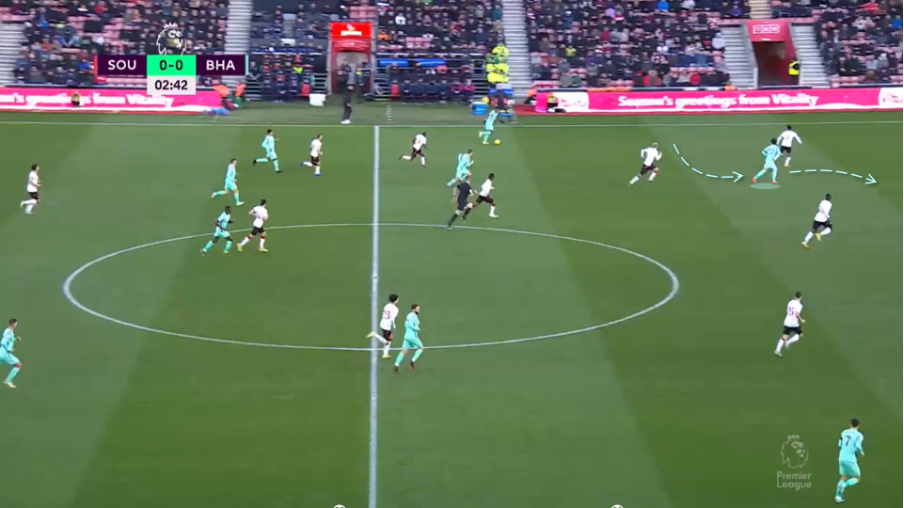
Brighton’s edge isn’t their ability to manipulate space, but rather, the relative timings at which they play with.
Conclusion
Roberto De Zerbi’s Brighton are a unique side in the way they gain advantages by creating unorthodox phases of play. While much of this tactically is predicated upon inducing effects on the opposition, Brighton could be seen to do this through how they speed up/slow down play in different scenarios, sometimes counterintuitively. Pausing to the extent that Brighton do in build-up is risky and generally seen as bad practice. But it is the essence of their game, and it disarms teams, perhaps because it is that unusual. Brighton maximise the upside of this approach by subsequently progressing and attacking with deadly speed, and this is facilitated by the player positioning and angles, as well as it being a downstream effect of the initial slowing of tempo in build-up.
Header image copyright IMAGO/ Offside Sports Photography

